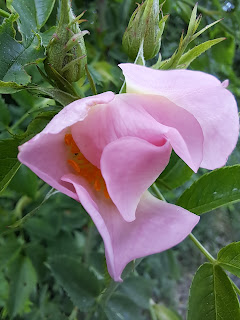Ja wohl bin ich nur ein Wandrer, ein Waller auf der Erde! Seid ihr denn mehr?
(Once more I am a wanderer, a pilgrim, through the world. But are you anything more?)
― Johann Wolfgang von Goethe, The Sorrows of Young Werther (1774)
Today I followed the route of the Jakobus Pilgerweg, or Jakobweg - the name applied to the German paths leading toward the Camino de Santiago in Spain. For the first part of the day, the Via Romea Germanica and Jakobsweg routes coincided. They diverged just outside Kühlenthal, where the Via Romea turns off toward Meitingen, while I continued straight southwards on the Jakobus Pilgerweg in order to end the day's stage at a guesthouse in Biberbach. The two routes converge again at Augsburg, and then continue southwards along parallel but different paths, allowing me to choose whichever route appears more attractive and offers the most convenient options in terms of accommodations.
 |
| Screenshot showing the routes of the Via Romea Germanica (in blue) and the Jakobus Pilgerweg (in red) |
And so, after doing justice to the breakfast buffet at Kloster Holzen, I left the former monastery behind and followed the signage for the two pilgrim ways - until I came to a road that was closed to traffic due to construction work. "Including cyclists and pedestrians," the sign specified, in very simple German that even I could understand! A quick check of Google Maps satellite view revealed that I could follow another, parallel dirt road on the other side of the stream and rejoin the official route in Blankenburg.
 |
| The roadworks requiring a detour |
I had a good view of the construction project from across the stream; it involved consolidating the river bank at a bend in the stream, where the river was eroding and undercutting the road. I crossed the stream and rejoined the official, marked route in Blankenburg, zigzagging uphill to the top of the escarpment and following a dirt road along its top, between the wheatfields and the forest. The road then turned into the forest, which was not as pretty as it might sound; it was clearly a managed forest, or tree farm, where spindly tall trunks were densely planted in rows, and patches had been cleared, planted with new saplings and fenced off to protect them from being devoured by deer while still small and tender.
The trail descended again and emerged from the woods into Kühlenthal, skirting the edge of the village along a dirt track and then crossing through the fields again. At one point the trail markers suggested that I should go back into the woods, but I could clearly see the white houses and red rooftops of the town of Markt straight ahead of me, and the gravel road across the fields to the village was perfectly good for walking, so I saw no reason to go veering off into the forest again! I thus made an already short stage even shorter, and by eleven o'clock I was already at my destination, Biberbach.
 |
| Love the elegant pedestrians on the sign marking the footpath into Biberbach! |
 |
| Edith's Bioladen und Café |
My first stop in Biberbach was Edith's Bioladen und Café, an organic food shop and café that seemed to be a popular local meeting-place. After the morning's breakfast buffet I didn't really need lunch, but I sat down for a slice of delicious cheesecake before proceeding on to Gasthaus Huckerwirt, my guesthouse next door to the pilgrimage church of St. Jakob. The guesthouse's beer hall and restaurant is closed on Thursdays, but I found my key and let myself in according to the instructions I had been sent, went to my room and lay down to enjoy the luxury of an afternoon nap, while the rain showers forecast for the afternoon passed over!
I only walked 13 kilometres today, but my body told me that 30 hours of train travel followed by 30 kilometres of walking in my first two days on the trail were enough, and demanded a break!
Biberbach and Jakob Fugger, a businessman with a social conscience
The village of Biberbach is documented as far bach (oops, back!) as the year 1070. In 1514 the land in the area was purchased by prominent merchant, mining entrepreneur and banker Jakob Fugger the Rich. A member of the well-known Fugger family of merchants from the city of Augsburg, who had grown wealthy on the Italian textile trade, Jakob expanded his family's business all over Europe and held a virtual monopoly on copper mining; his personal wealth was estimated to be equivalent to 2% of the total GDP of Europe at the time!
 |
| Portrait of Jakob Fugger, by Albrecht Dürer |
Like certain present-day entrepreneurs and innovators, Fugger wielded considerable influence over world politics, financing the rise of the Holy Roman Emperor Maximilian I and securing the election of Spanish King Charles I as Holy Roman Emperor Charles V. But unlike them, Fugger also had an artistic and social conscience: in 1509 Jakob the Rich funded the construction of Germany's first Renaissance building - the chapel in Augsburg where he and his brothers are buried - and in 1521 he founded the oldest social housing complex in the world still used for its original purpose, the Fuggerei. Catholic citizens of Augsburg can still apply to live in the Fuggerei for an annual rent of 88 cents, provided they promise to say their prayers three times a day.





















No comments:
Post a Comment